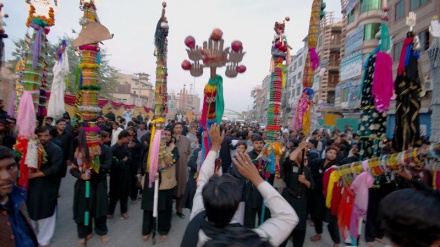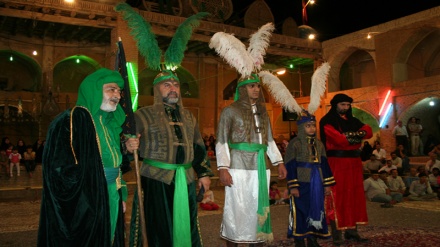Muharram mourning traditions in different lands - 24
Welcome to the 24th part of the 40-plus episodes of a new and interesting series titled “Muharram mourning traditions in different lands” that we started broadcasting as of October 15 on a daily basis, to commemorate the heartrending tragedy of Karbala, and the martyrdom of Imam Husain (AS), the grandson of Prophet Mohammad (SAWA).
In this series, which delves into the various mourning traditions associated with the Immortal Epic of Ashura in various lands, we look at the history of mourning for Imam Husain (AS) in Anatolia or what is now Turkey.
Ashura or the 10th of Muharram is the climax to the mourning ceremonies of the month of Muharram. It is the day marked by Muslims around the world to commemorate the anniversary of the heartrending tragedy of Karbala. As a matter of fact, Ashura is at its core a day of mourning against injustice, and has been marked by people of all faiths across large swathes of South, Central, and Western Asia for centuries.
As far as the Caribbean islands in the New World and Indonesia in southeaster Asia, forms of Ashura ceremonies take place. In South Asia in particular, the day of mourning processions and colorful marches has become a highly intercommunal occasion often featuring participation from Muslims of all stripes as well as Hindus and others. In countries like Egypt, Qatar, or Saudi Arabia, where significant but nearly invisible Shi’a Muslim communities reside, rituals associated with the month of Muharram are often the only time when communal identity surfaces and makes itself heard.
Although as a result of the Fatemid Dynasty many Egyptian Sunnis maintain a level of reverence for the family of the Prophet, if it weren’t for the yearly Ashura commemorations by thousands of Egyptian Shias at the al-Husain Mosque in Cairo (where the head of the Prophet’s grandson is believed to be interred), the presence of an actually existing Shi’a Muslim community of around 3 million in the country would scarcely be known. Unfortunately, in some countries, the regimes which are detached from the teachings of the Prophet’s Ahl al-Bayt, have adopted a hostile policy against Shi’a Muslims, and banned the Muharram mourning ceremonies.
Turkey, however, offers a unique case study, wherein Shi’a Muslim identity is not formally forbidden but where the diversity of Shi’a groups and the supposedly homogenous ethnic and religious character of the official narrative of national identity often works to suppress knowledge or visibility of the followers of the Ahl al-Bayt in Turkey. Muharram and its mourning ceremonies are the prime time that witnesses the manifestation of those devoted to the household of Prophet Mohammad (SAWA). The primary Shi’a Muslim group in Turkey is Alevism, a branch of the faith that traces its theological lineage through the Ja’fari school of jurisprudence but with strong Sufi elements – but is distinct from Syrian-oriented Alawism.
Although the practices of this group are diverse, Muharram is typically commemorated in a different form by Alevis, Let us, however, dwell on the commemoration of Ashura and the mourning ceremonies in the month of Muharram by the Ithna Ash’ari or Twelver Shi’a Muslim community living in Istanbul. Twelver Shi’as are the largest Shi’a Muslim community in the world, being dominant in Iran, Iraq, Lebanon, Bahrain, Pakistan, India, and many other countries, except for Yemen, where the Zaid Shi’as are the majority. While official figures are difficult to come by, figures suggest there are about three million Twelver Shi’a Muslims of Azeri descent living in Turkey: one million in Istanbul and two million in other parts of Turkey. There are millions of other Shi’as, who along with Alevis, make up some 25 percent of the population of Turkey. Today, it is estimated that there are 40 Shia mosques in Istanbul and 300 more in Turkey.
The Muharram mourning ceremonies take place in the historically Shi‘a Muslim neighborhood of Zaynabiye in Istanbul, which holds a particularly important place in the hearts of many Shi’a Muslims, as it is believed that Hazrat Narjis, the mother of the Imam of the Age, Hazrat Mahdi (AS), the Prophet’s 12th and Last Infallible Successor, who is in occultation and who will appear in the end time to establish the global government of peace, prosperity and justice, traces her own lineage to the area, which in her time was the capital of the Byzantine Empire, and she was the granddaughter of the Byzantine Emperor.
In recent years, the large attendance of the ceremony has even included visits from heads of state, including Turkish president Rajab Tayyeb Erdoghan, pointing to official acceptance and support for the community even while they remain nearly invisible in the national consciousness. The commemorations include a march as well as a taziyeh, a ritual re-enactment of the Battle of Karbala before spectators. This is followed by mourning discourses, beating of chests in grief, and flagellation by chains on the backs by men. Ashura or Ashureh as the Turks call, is famous for a dish called Ashure Tatil or Noah’s Pudding, which is shared among friends and family. The Muslims of Turkey have carried this tradition to the Balkans, where in Albania, the Bektashi Sufi Order, commemorates the Muharram mourning ceremonies, with the climax being the day of Ashura.
That is all for today, God bless you and goodbye, till we meet again tomorrow with another interesting episode.
MD/AS/EA


